navigation NISSAN LEAF 2020 Owner´s Manual
[x] Cancel search | Manufacturer: NISSAN, Model Year: 2020, Model line: LEAF, Model: NISSAN LEAF 2020Pages: 596, PDF Size: 4.33 MB
Page 5 of 596
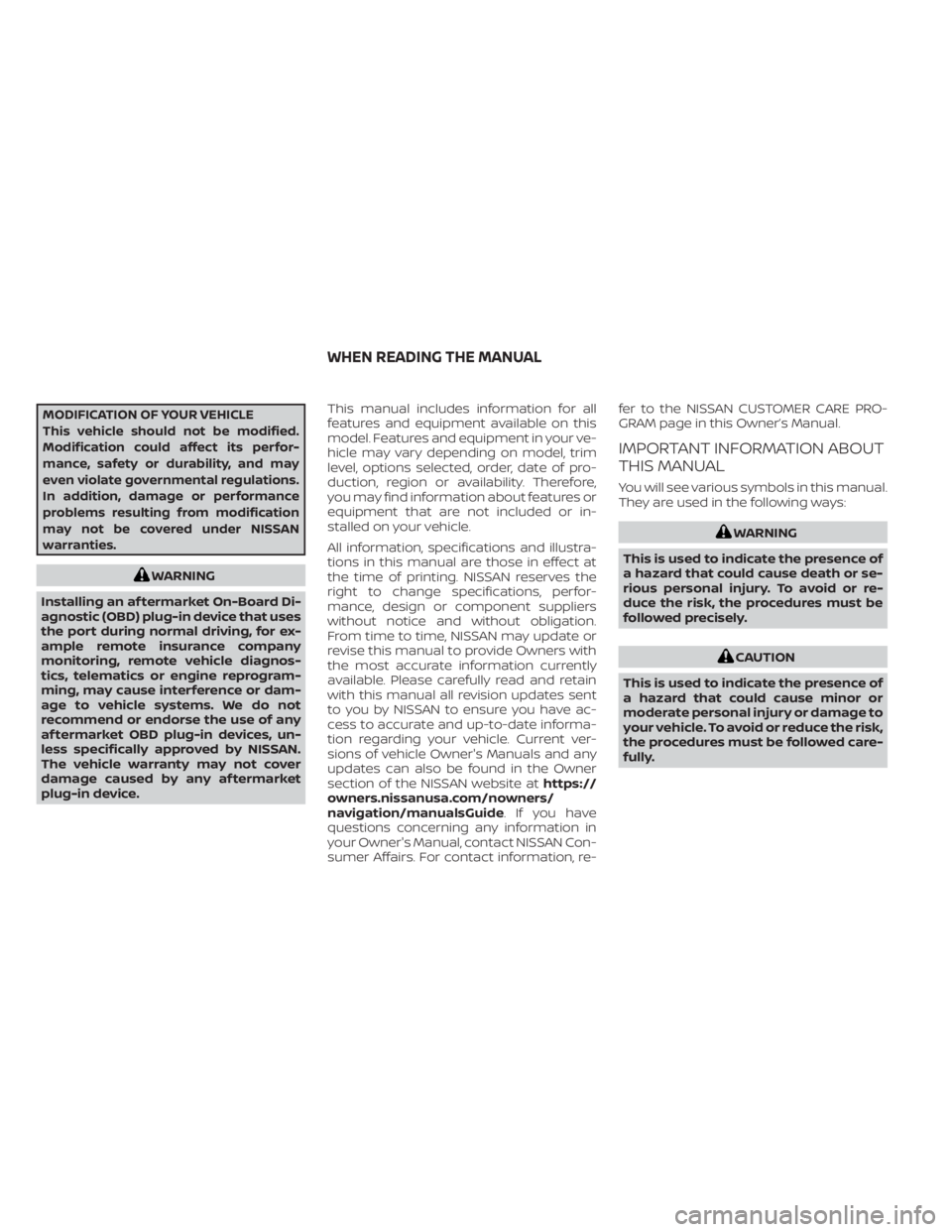
MODIFICATION OF YOUR VEHICLE
This vehicle should not be modified.
Modification could affect its perfor-
mance, safety or durability, and may
even violate governmental regulations.
In addition, damage or performance
problems resulting from modification
may not be covered under NISSAN
warranties.
WARNING
Installing an af termarket On-Board Di-
agnostic (OBD) plug-in device that uses
the port during normal driving, for ex-
ample remote insurance company
monitoring, remote vehicle diagnos-
tics, telematics or engine reprogram-
ming, may cause interference or dam-
age to vehicle systems. We do not
recommend or endorse the use of any
af termarket OBD plug-in devices, un-
less specifically approved by NISSAN.
The vehicle warranty may not cover
damage caused by any af termarket
plug-in device. This manual includes information for all
features and equipment available on this
model. Features and equipment in your ve-
hicle may vary depending on model, trim
level, options selected, order, date of pro-
duction, region or availability. Therefore,
you may find information about features or
equipment that are not included or in-
stalled on your vehicle.
All information, specifications and illustra-
tions in this manual are those in effect at
the time of printing. NISSAN reserves the
right to change specifications, perfor-
mance, design or component suppliers
without notice and without obligation.
From time to time, NISSAN may update or
revise this manual to provide Owners with
the most accurate information currently
available. Please carefully read and retain
with this manual all revision updates sent
to you by NISSAN to ensure you have ac-
cess to accurate and up-to-date informa-
tion regarding your vehicle. Current ver-
sions of vehicle Owner's Manuals and any
updates can also be found in the Owner
section of the NISSAN website at
https://
owners.nissanusa.com/nowners/
navigation/manualsGuide . If you have
questions concerning any information in
your Owner's Manual, contact NISSAN Con-
sumer Affairs. For contact information, re- fer to the NISSAN CUSTOMER CARE PRO-
GRAM page in this Owner’s Manual.
IMPORTANT INFORMATION ABOUT
THIS MANUAL
You will see various symbols in this manual.
They are used in the following ways:
WARNING
This is used to indicate the presence of
a hazard that could cause death or se-
rious personal injury. To avoid or re-
duce the risk, the procedures must be
followed precisely.
CAUTION
This is used to indicate the presence of
a hazard that could cause minor or
moderate personal injury or damage to
your vehicle. To avoid or reduce the risk,
the procedures must be followed care-
fully.
WHEN READING THE MANUAL
Page 22 of 596
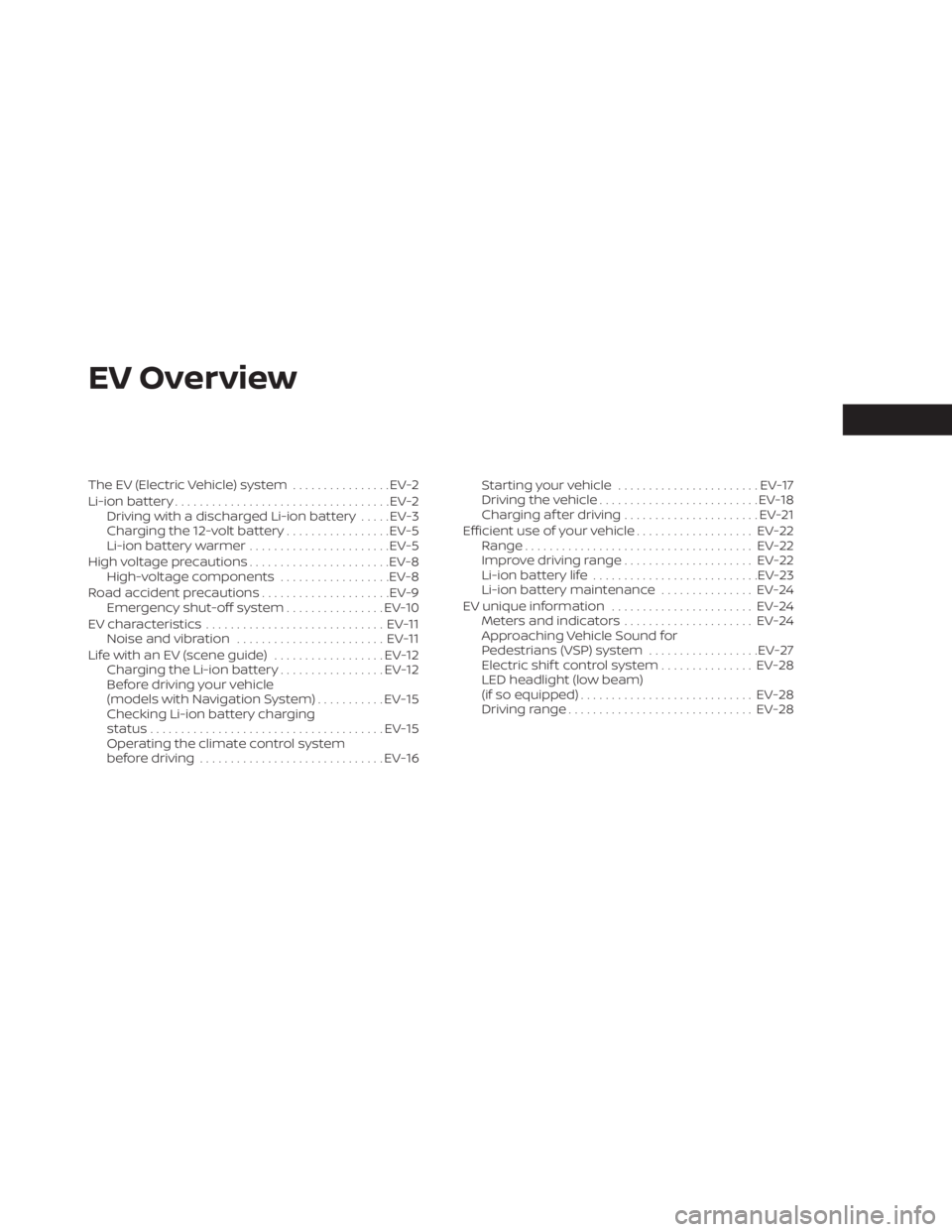
EV Overview
The EV (Electric Vehicle) system................EV-2
Li-ion battery ................................... EV-2
Driving with a discharged Li-ion battery .....EV-3
Charging the 12-volt battery .................EV-5
Li-ion battery warmer .......................EV-5
High voltage precautions .......................EV-8
High-voltage components ..................EV-8
Road accident precautions .....................EV-9
Emergency shut-off system ................EV-10
EV characteristics ............................. EV-11
Noise and vibration ........................ EV-11
Life with an EV (scene guide) ..................EV-12
Charging the Li-ion battery .................EV-12
Before driving your vehicle
(models with Navigation System) ...........EV-15
Checking Li-ion battery charging
status ...................................... EV-15
Operating the climate control system
before driving .............................. EV-16Starting your vehicle
....................... EV-17
Driving the vehicle .......................... EV-18
Charging af ter driving ......................EV-21
Efficient use of your vehicle ...................EV-22
Range ..................................... EV-22
Improve driving range .....................EV-22
Li-ion battery life ........................... EV-23
Li-ion battery maintenance ...............EV-24
EV unique information .......................EV-24
Meters and indicators .....................EV-24
Approaching Vehicle Sound for
Pedestrians (VSP) system ..................EV-27
Electric shif t control system ...............EV-28
LED headlight (low beam)
(if so equipped) ............................ EV-28
Driving range .............................. EV-28
Page 24 of 596
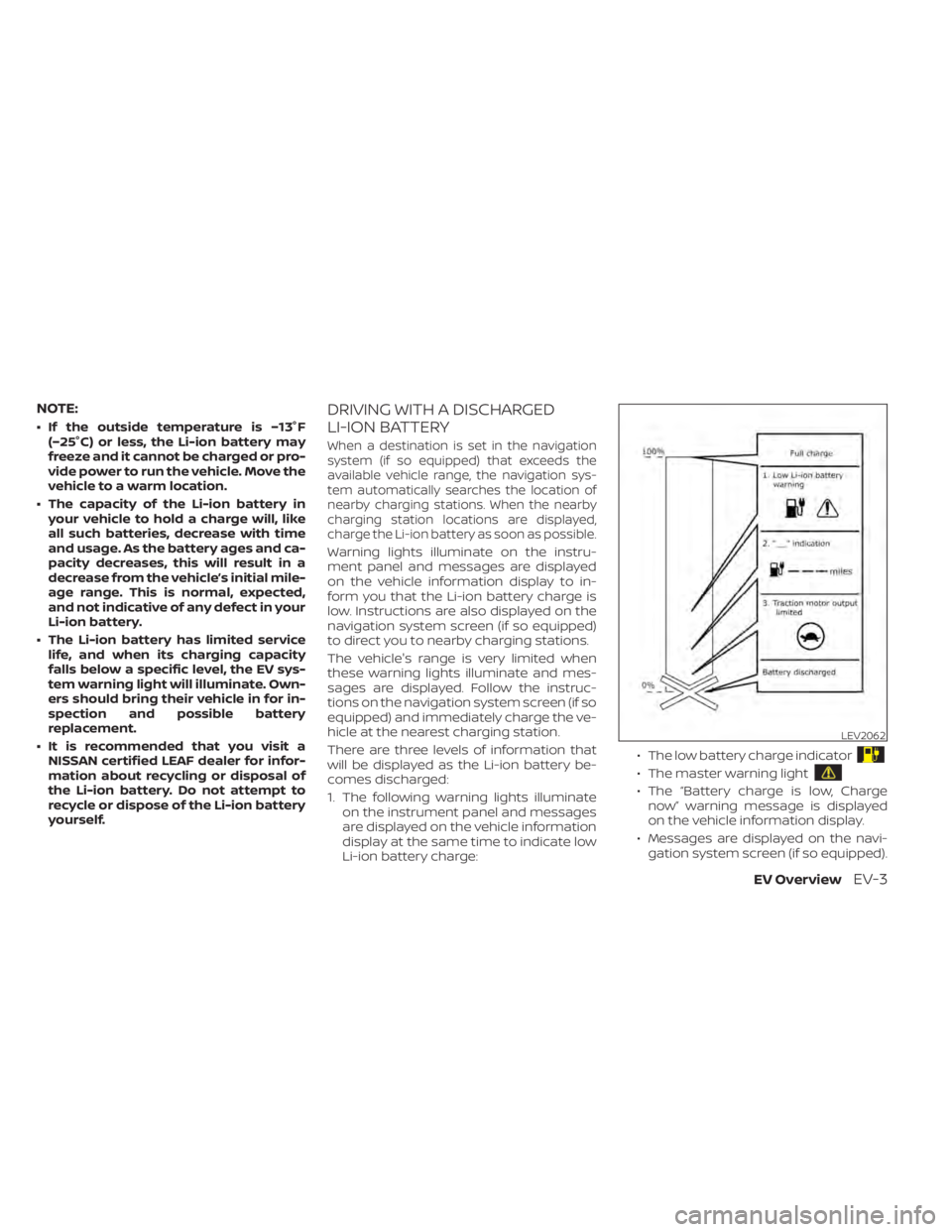
NOTE:
• If the outside temperature is −13°F(−25°C) or less, the Li-ion battery may
freeze and it cannot be charged or pro-
vide power to run the vehicle. Move the
vehicle to a warm location.
• The capacity of the Li-ion battery in your vehicle to hold a charge will, like
all such batteries, decrease with time
and usage. As the battery ages and ca-
pacity decreases, this will result in a
decrease from the vehicle’s initial mile-
age range. This is normal, expected,
and not indicative of any defect in your
Li-ion battery.
• The Li-ion battery has limited service life, and when its charging capacity
falls below a specific level, the EV sys-
tem warning light will illuminate. Own-
ers should bring their vehicle in for in-
spection and possible battery
replacement.
• It is recommended that you visit a NISSAN certified LEAF dealer for infor-
mation about recycling or disposal of
the Li-ion battery. Do not attempt to
recycle or dispose of the Li-ion battery
yourself.
DRIVING WITH A DISCHARGED
LI-ION BATTERY
When a destination is set in the navigation
system (if so equipped) that exceeds the
available vehicle range, the navigation sys-
tem automatically searches the location of
nearby charging stations. When the nearby
charging station locations are displayed,
charge the Li-ion battery as soon as possible.
Warning lights illuminate on the instru-
ment panel and messages are displayed
on the vehicle information display to in-
form you that the Li-ion battery charge is
low. Instructions are also displayed on the
navigation system screen (if so equipped)
to direct you to nearby charging stations.
The vehicle's range is very limited when
these warning lights illuminate and mes-
sages are displayed. Follow the instruc-
tions on the navigation system screen (if so
equipped) and immediately charge the ve-
hicle at the nearest charging station.
There are three levels of information that
will be displayed as the Li-ion battery be-
comes discharged:
1. The following warning lights illuminate on the instrument panel and messages
are displayed on the vehicle information
display at the same time to indicate low
Li-ion battery charge: • The low battery charge indicator
• The master warning light
• The “Battery charge is low, Charge
now” warning message is displayed
on the vehicle information display.
• Messages are displayed on the navi- gation system screen (if so equipped).
LEV2062
EV OverviewEV-3
Page 25 of 596
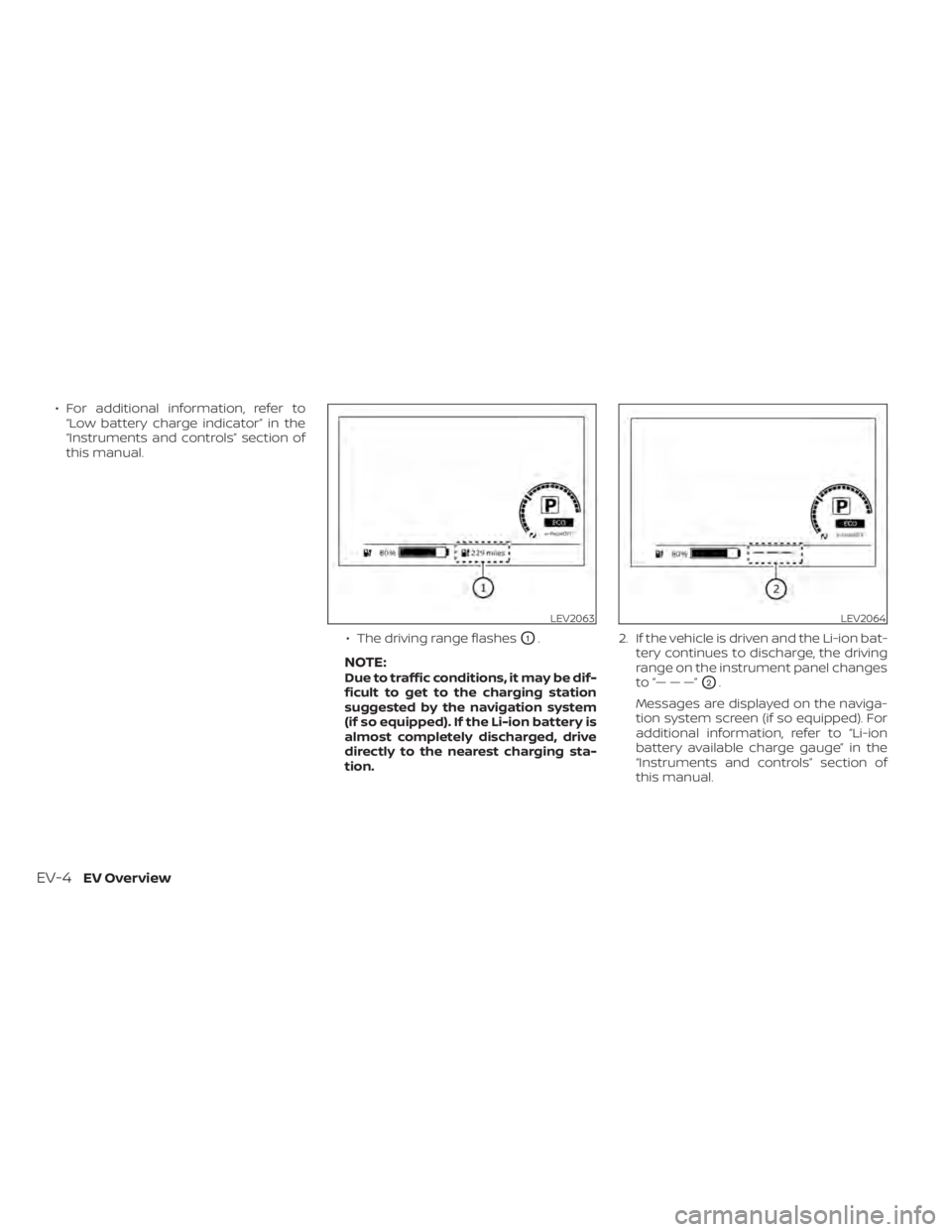
• For additional information, refer to“Low battery charge indicator” in the
“Instruments and controls” section of
this manual.
• The driving range flashes
O1.
NOTE:Due to traffic conditions, it may be dif-
ficult to get to the charging station
suggested by the navigation system
(if so equipped). If the Li-ion battery is
almost completely discharged, drive
directly to the nearest charging sta-
tion.2. If the vehicle is driven and the Li-ion bat-
tery continues to discharge, the driving
range on the instrument panel changes
to “— — —”O2.
Messages are displayed on the naviga-
tion system screen (if so equipped). For
additional information, refer to “Li-ion
battery available charge gauge” in the
“Instruments and controls” section of
this manual.
LEV2063LEV2064
EV-4EV Overview
Page 27 of 596
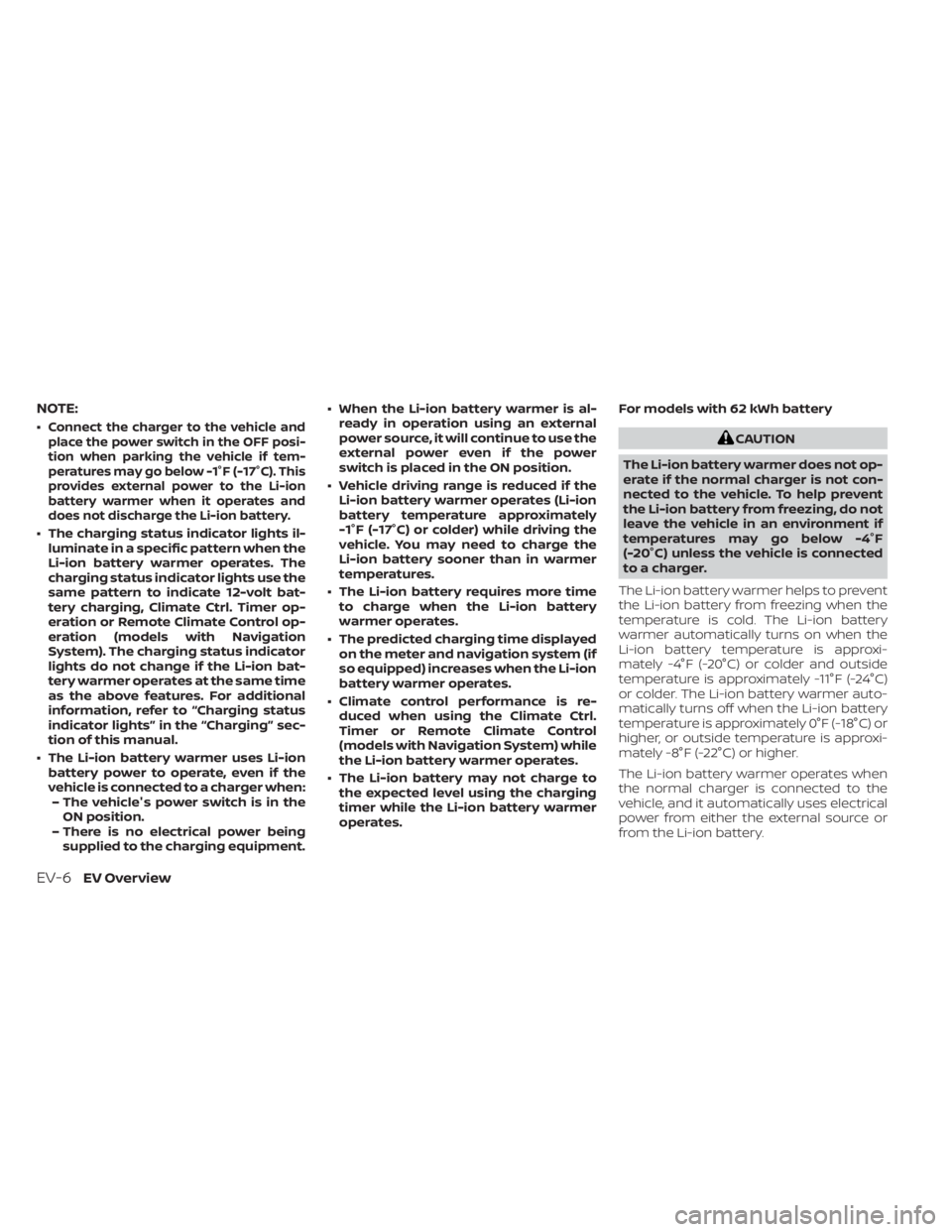
NOTE:
•Connect the charger to the vehicle and
place the power switch in the OFF posi-
tion when parking the vehicle if tem-
peratures may go below -1°F (-17°C). This
provides external power to the Li-ion
battery warmer when it operates and
does not discharge the Li-ion battery.
• The charging status indicator lights il- luminate in a specific pattern when the
Li-ion battery warmer operates. The
charging status indicator lights use the
same pattern to indicate 12-volt bat-
tery charging, Climate Ctrl. Timer op-
eration or Remote Climate Control op-
eration (models with Navigation
System). The charging status indicator
lights do not change if the Li-ion bat-
tery warmer operates at the same time
as the above features. For additional
information, refer to “Charging status
indicator lights” in the “Charging” sec-
tion of this manual.
• The Li-ion battery warmer uses Li-ion battery power to operate, even if the
vehicle is connected to a charger when:– The vehicle's power switch is in the ON position.
– There is no electrical power being supplied to the charging equipment. • When the Li-ion battery warmer is al-
ready in operation using an external
power source, it will continue to use the
external power even if the power
switch is placed in the ON position.
• Vehicle driving range is reduced if the Li-ion battery warmer operates (Li-ion
battery temperature approximately
-1°F (-17°C) or colder) while driving the
vehicle. You may need to charge the
Li-ion battery sooner than in warmer
temperatures.
• The Li-ion battery requires more time to charge when the Li-ion battery
warmer operates.
• The predicted charging time displayed on the meter and navigation system (if
so equipped) increases when the Li-ion
battery warmer operates.
• Climate control performance is re- duced when using the Climate Ctrl.
Timer or Remote Climate Control
(models with Navigation System) while
the Li-ion battery warmer operates.
• The Li-ion battery may not charge to the expected level using the charging
timer while the Li-ion battery warmer
operates. For models with 62 kWh battery
CAUTION
The Li-ion battery warmer does not op-
erate if the normal charger is not con-
nected to the vehicle. To help prevent
the Li-ion battery from freezing, do not
leave the vehicle in an environment if
temperatures may go below -4°F
(-20°C) unless the vehicle is connected
to a charger.
The Li-ion battery warmer helps to prevent
the Li-ion battery from freezing when the
temperature is cold. The Li-ion battery
warmer automatically turns on when the
Li-ion battery temperature is approxi-
mately -4°F (-20°C) or colder and outside
temperature is approximately -11°F (-24°C)
or colder. The Li-ion battery warmer auto-
matically turns off when the Li-ion battery
temperature is approximately 0°F (-18°C) or
higher, or outside temperature is approxi-
mately -8°F (-22°C) or higher.
The Li-ion battery warmer operates when
the normal charger is connected to the
vehicle, and it automatically uses electrical
power from either the external source or
from the Li-ion battery.
EV-6EV Overview
Page 28 of 596

NOTE:
• Connect the charger to the vehicle andplace the power switch in the OFF po-
sition when parking the vehicle if tem-
peratures may go below -4°F (-20°C).
The Li-ion battery warmer automati-
cally uses electrical power from either
the external source or from the Li-ion
battery, based on the amount of re-
maining Li-ion battery.
• The charging status indicator lights il- luminate in a specific pattern when the
Li-ion battery warmer operates. The
charging status indicator lights use the
same pattern to indicate 12–volt bat-
tery charging, Climate Ctrl. Timer op-
eration or Remote Climate Control op-
eration (models with Navigation
System). The charging status indicator
lights do not change if the Li-ion bat-
tery warmer operates at the same time
as the above features. For additional
information, refer to “Charging status
indicator lights” in the “Charging” sec-
tion of this manual. • The automatic climate control auto-
matically turns on when the Li-ion bat-
tery warmer uses electrical power
from the Li-ion battery. This is not a
malfunction. When the Li-ion battery
warmer operates, the temperature in-
side the vehicle may be warmed up.
• The Li-ion battery will be automatically charged when the Li-ion battery
warmer uses electrical power from an
extended source. When outside tem-
perature goes below -4°F (-20°C) for
many days, frequent Li-ion battery
warmer operation may occur, and
more electric power will be charged
from an external source. Do not con-
nect the normal charger to the vehicle
if you do not want to turn on the Li-ion
battery warmer. In this case, do not
leave the vehicle in an environment if
temperatures may go below -4°F
(-20°C).
• When the Li-ion battery warmer is al- ready in operation using an external
source, it will continue to use the exter-
nal power even if the power switch is
placed in the ON position. • The Li-ion battery warmer will stop if
the power switch is placed in the ON
position while the Li-ion battery
warmer is using electrical power from
the Li-ion battery. To turn on the Li-ion
battery warmer again, place the power
switch in the OFF position.
• The Li-ion battery warmer will stop if the charging connector is removed
from the normal charger while the Li-
ion battery warmer is operating. To
turn on the Li-ion battery warmer
again, connect the charging connector
to the vehicle. The Li-ion battery
warmer will operate again af ter about
1 hour.
• The Li-ion battery warmer will stop if the charging connector of the quick
charger is connected to the vehicle
while the Li-ion battery warmer is op-
erating. To turn on the Li-ion battery
warmer again, remove the charging
connector of the quick charger from
the vehicle.
• The Li-ion battery requires more time to charge to the expected level when
the Li-ion battery warmer operates.
EV OverviewEV-7
Page 29 of 596

• The predicted charging time displayedon the meter increases when the Li-ion
battery warmer uses electrical power
from the Li-ion battery.
• The Climate Ctrl. Timer or Remote Cli- mate Control (models with Navigation
System) does not turn on while the Li-
ion battery warmer operates. This is
not a malfunction.
• The charging timer or remote charge (models with Navigation System) does
not turn on while the Li-ion battery
warmer operates. This is not a mal-
function.
• The Li-ion battery may not be charged to the expected level using the charg-
ing timer while the Li-ion battery
warmer operates.
• If the Li-ion battery warmer automati- cally stops because of the Li-ion bat-
tery temperature or outside tempera-
ture change, charging will continue
until the Li-ion battery is fully charged.HIGH-VOLTAGE COMPONENTS
WARNING
• The EV system uses high voltage up
to approximately DC 400 volt. The
system can be hot during and af ter
starting and when the vehicle is shut
off. Be careful of both the high volt-
age and the high temperature. Fol-
low the warning labels that are at-
tached to the vehicle.
• Never disassemble, remove or re-
place high-voltage parts and cables
as well as their connectors because
they can cause severe burns or elec-
tric shock that may result in serious
injury or death. High-voltage cables
are colored orange. The vehicle high
voltage system has no user service-
able parts. It is recommended that
you take your vehicle to a NISSAN
certified LEAF dealer for any neces-
sary maintenance.
HIGH VOLTAGE PRECAUTIONS
EV-8EV Overview
Page 33 of 596

• Compressor and radiator fan noise whenthe Climate Ctrl. Timer or remote climate
control (models with Navigation System)
is used.
• Relay operation noise and vibration at start-up and shut-down of the EV system
(power switch placed in the ON and OFF
position).
• Approaching Vehicle Sound for Pedestri- ans (VSP). This section provides a brief explanation
for the most important LEAF functions. For
additional information, refer to the specific
sections of this manual for detailed expla-
nations of the vehicle features and opera-
tion.CHARGING THE LI-ION BATTERY
WARNING
The EV system uses a high voltage cur-
rent. Failure to follow the proper han-
dling instructions may cause serious
injury or death. Be sure to read the
“Charging” section and follow the pro-
cedures and guidelines described.
LIFE WITH AN EV (scene guide)
EV-12EV Overview
Page 36 of 596

BEFORE DRIVING YOUR VEHICLE
(models with Navigation System)
The Li-ion battery charging status and the
Li-ion battery warmer (if so equipped) op-
eration can be checked using an internet
enabled smart phone or personal com-
puter at home. You may also choose to
have SMS messages (text messages) sent
to a cellular phone. Additionally, the vehi-
cle’s heater and air conditioner can be set
to operate using the Climate Ctrl. Timer
function or A/C-heater remote function, if
necessary. For additional information, refer
to “Remote climate control” in the “Monitor,
climate, audio, phone and voice recogni-
tion systems” section of this manual.
NOTE:
• To check the Li-ion battery chargingstatus or to use the remote heater and
air conditioner using an internet en-
abled smart phone or personal com-
puter, the following conditions must be
met:– The vehicle must be located in a cel- lular phone or smart phone cover-
age area. – The internet enabled cellular phone
or smart phone must be located in a
cellular phone or smart phone cov-
erage area.
– The computer must be connected to the internet.
– A cellular phone must be used to communicate with the vehicle.
– A cellular phone capable of text mes- saging must be used to receive text
message regarding vehicle charge
status.
• The remote heater and cooler can ad- just the in-cabin temperature.
• When the charge connector is discon- nected from the vehicle, the heater and
air conditioner operates using vehicle
Li-ion battery electric power.
• If the remote heater and air condi- tioner function and Li-ion battery
charging are performed at the same
time, Li-ion battery charging will take
longer than usual due to the power
used to heat or cool the vehicle.
CHECKING LI-ION BATTERY
CHARGING STATUS
The Li-ion battery charge status can be
checked on the NISSAN Data Center web-
site via an internet enabled smart phone or
personal computer.
If the Li-ion battery is not sufficiently
charged, you can start charging the Li-ion
battery via the remote charge function. For
additional information, refer to “Charging
related remote function” in the “Charging”
section of this manual.
LEV2046
EV OverviewEV-15
Page 38 of 596

STARTING YOUR VEHICLE
1. Depress the brake pedalO1.
2. Push the power switch
O2.
3. Check that the READY to drive indicator light
O3illuminates. For additional infor-
mation, refer to “READY to drive indicator
light” in the “Instruments and controls”
section of this manual.
4. For models with Navigation System: If route guidance is necessary, enter the
destination in the navigation system.
For additional information, refer to the
NissanConnect® Manual (for Leaf ). 5. Check the Li-ion battery level and the
estimated driving range shown on the
meter. For additional information, refer
to “Driving range” in the “Instruments
and controls” section of this manual.
NOTE:
• For additional information, refer to“Range” in this section.
• Before driving, compare the driving distance to the destination displayed
on the navigation system screen (if so
equipped) with the estimated driving
range shown on the meter. Determine
if it will be necessary to charge the Li-
ion battery before or while driving to
your planned destination.
• If it is necessary to charge the Li-ion battery, use the navigation system (if
so equipped) to search for available
charging stations on your planned
driving route.
LEV2066
LEV2093
EV OverviewEV-17